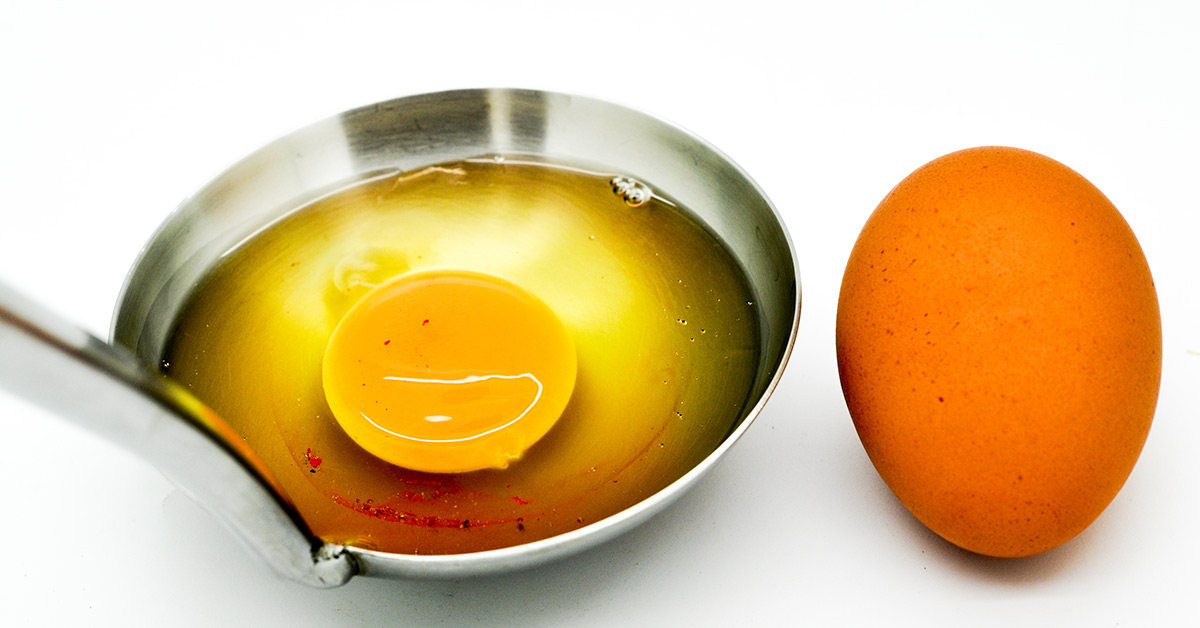Have you ever cracked open an egg to find a little red blood spot in it? If you have, what did you do with the egg? Did you throw it away, or did you shrug your shoulders and continue cooking with it? Many people are unsure if these eggs are still safe to eat. We’re going to clear up all of the confusion for you as to how and why these spots happen, what they signify, and, of course, if they are still safe to eat.
Are Eggs With Blood Spots Safe To Eat?
You are likely reading this article because your main concern is whether or not eggs with blood spots are safe to eat. We will get straight to the point and tell you that, yes, they are – as long as they are properly cooked. They are completely harmless and won’t cause any illness. You can continue cooking with them as normal. If you prefer, you can also use the tip of a knife or something equally as small to remove the spot before cooking. (1)
Egg whites may also contain brown meat spots. These are little pieces of tissue picked up by the egg as it passes through the oviduct. They are also completely harmless. On the other hand, if an egg white is pink, red, or green in color, this egg should be discarded. It likely means that a potentially dangerous bacteria has grown in that egg and could make you sick. (2)
How Many Eggs Have Blood Spots?
Less than 1% of eggs will contain blood spots. If you are buying your eggs in a grocery store, it is very likely that you will never see one. This is because the grading process usually finds these spots and removes these eggs from the lineup. They use a process known as “candling” – the use of bright light to detect imperfections in each egg. For this reason, eggs with blood spots rarely make it to the consumer. Again, this has nothing to do with health risks and more to do with the fact that people just don’t find them appealing.
With farm-fresh eggs, however, you are slightly more likely to see the occasional blood spot. These eggs do not undergo the same process and of course, these farmers don’t have access to the same technology. Additionally, brown eggs are more likely to have spots because the darker shells make them harder to detect.
Read: Are cheaper eggs just as nutritious as organic or free-run options?
Why Do Some Eggs Have Blood Spots?
A common myth is that blood spots mean the egg was fertilized. This is false information. Rather, blood spots are the result of the rupturing of tiny blood vessels in the hen’s ovaries or oviduct. The oviduct is the passageway between the ovaries and the outside environment.
Blood spots can occur in both the yolk and the white. A blood spot in the yolk means that the bleeding occurred in the ovary when the hen released the egg from the follicle. If the spot is in the white, this means the bleeding happened after the hen released the egg into the oviduct.
Always Cook Your Eggs Properly
Beyond blood spots, you should always store and cook your eggs properly. If your eggs are store-bought, you should keep them in the fridge. Farm fresh eggs can be left at room temperature, however, ensure that where they are stored doesn’t have too much light and isn’t too warm. Don’t consume eggs with cracks in the shells – this is a prime opportunity for bacteria to enter that egg. Once cooked, eggs can last in the fridge for up to one week. (3)
When cooking, always wash your hands before handling the eggs. Wash them afterward, as well. Cook the eggs until both the egg yolk and white are firm. Consuming any amount of raw egg increases your risk of salmonella poisoning. If you are making a recipe that requires the use of undercooked or raw eggs, be sure to use eggs that have been pasteurized to treat salmonella and other bacteria. This will also help to reduce your risk of developing food poisoning.
When transporting eggs, keep them at the appropriate temperature. If you are packing them in a lunch pail or picnic basket, ensure that they are in a cooler or next to an ice pack to keep them cold. Of course, keep them out of direct sunlight.
Finally, know the signs of food poisoning. Vomiting, diarrhea, and abdominal cramps are all symptoms. Other flu symptoms such as muscle pain, headache, and fever are also included. Visit your doctor, who can help give you what you need to successfully combat your food-borne illness. Rest and drink plenty of fluids. Finally, report your food-borne illness to the FDA. Sometimes it is a one-off thing, but other times it is the result of a wider problem that could potentially affect hundreds or even thousands of people.
Keep Reading: Guy Finds Weird Bead-Like Stuff In Eggs And Asks The Internet If It’s Safe
Sources
- “Is it okay to eat eggs with a blood spot in it?” Eggs
- “Are Eggs With Blood Spots Safe to Eat?” Healthline. Jillian Kubala, MS, RD. February 4, 2019.
- “What You Need to Know About Egg Safety.” FDA

